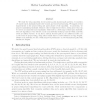Free Online Productivity Tools
i2Speak
i2Symbol
i2OCR
iTex2Img
iWeb2Print
iWeb2Shot
i2Type
iPdf2Split
iPdf2Merge
i2Bopomofo
i2Arabic
i2Style
i2Image
i2PDF
iLatex2Rtf
Sci2ools
WEA
2007
Springer
2007
Springer
Better Landmarks Within Reach
We study the real algorithm for the point-to-point shortest path problem. It combines A∗ search search, landmark-based lower bounds, and reach-based pruning. We suggest several improvements to the preprocessing and query phases of the algorithm. In particular, we propose maintaining landmark distances only for high-reach vertices, saving space that can be used to accommodate more landmarks. This leads to a wide range of time-space tradeoffs. The new algorithm is very effective on the road networks of Europe and the USA, each with about 20 million vertices: it can find a random shortest path in one millisecond after one or two hours of preprocessing, using either transit times or travel distances as edge weights. Besides road networks, we also obtain improved performance on two-dimensional grids with random arc lengths.
Algorithms | Landmark-based Lower Bounds | Point-to-point Shortest Path | Shortest Path | WEA 2007 |
| Added | 09 Jun 2010 |
| Updated | 09 Jun 2010 |
| Type | Conference |
| Year | 2007 |
| Where | WEA |
| Authors | Andrew V. Goldberg, Haim Kaplan, Renato Fonseca F. Werneck |
Comments (0)

